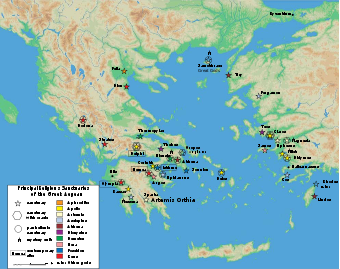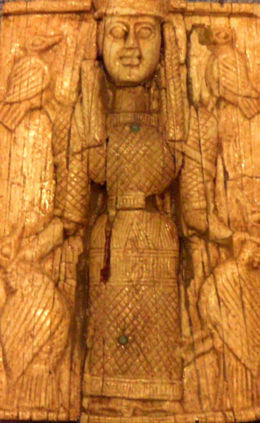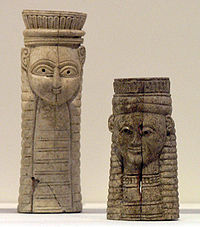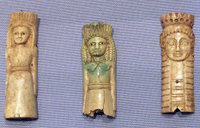
Artemis Orthia
Encyclopedia

Artemis
Artemis was one of the most widely venerated of the Ancient Greek deities. Her Roman equivalent is Diana. Some scholars believe that the name and indeed the goddess herself was originally pre-Greek. Homer refers to her as Artemis Agrotera, Potnia Theron: "Artemis of the wildland, Mistress of Animals"...
, was one of the most important religious sites in the Greek
Ancient Greece
Ancient Greece is a civilization belonging to a period of Greek history that lasted from the Archaic period of the 8th to 6th centuries BC to the end of antiquity. Immediately following this period was the beginning of the Early Middle Ages and the Byzantine era. Included in Ancient Greece is the...
city-state
Polis
Polis , plural poleis , literally means city in Greek. It could also mean citizenship and body of citizens. In modern historiography "polis" is normally used to indicate the ancient Greek city-states, like Classical Athens and its contemporaries, so polis is often translated as "city-state."The...
of Sparta
Sparta
Sparta or Lacedaemon, was a prominent city-state in ancient Greece, situated on the banks of the River Eurotas in Laconia, in south-eastern Peloponnese. It emerged as a political entity around the 10th century BC, when the invading Dorians subjugated the local, non-Dorian population. From c...
.
Sanctuary
The cult of Orthia (Greek ) was common to the four villages originally constituting Sparta: Limnai, in which it is situated, Pitana, Kynosoura and Mesoa. Chronologically speaking, it probably came after the cult to the city-goddess AthenaAthena
In Greek mythology, Athena, Athenê, or Athene , also referred to as Pallas Athena/Athene , is the goddess of wisdom, courage, inspiration, civilization, warfare, strength, strategy, the arts, crafts, justice, and skill. Minerva, Athena's Roman incarnation, embodies similar attributes. Athena is...
(Polioũkhos) "protectress of the city" or Χαλκίοικος / Khalkíoikos "of the bronze house".
The sanctuary is located in a natural basin between Limnai and the west bank of the Eurotas River
Eurotas River
The Eurotas or Evrotas is the main river of Laconia prefecture and one of the major rivers of the Peloponnese, in Greece. The river's springs are located just northwest of the border between Laconia and the prefecture of Arcadia, at Skortsinos. The river is also fed by underwater springs at...
, outside ancient Sparta, above the reach of all but the severest flooding. The oldest relics, pottery
Pottery
Pottery is the material from which the potteryware is made, of which major types include earthenware, stoneware and porcelain. The place where such wares are made is also called a pottery . Pottery also refers to the art or craft of the potter or the manufacture of pottery...
fragments from the late Greek Dark Ages
Greek Dark Ages
The Greek Dark Age or Ages also known as Geometric or Homeric Age are terms which have regularly been used to refer to the period of Greek history from the presumed Dorian invasion and end of the Mycenaean Palatial civilization around 1200 BC, to the first signs of the Greek city-states in the 9th...
, indicate that the cult has probably existed since the 10th century BCE, but not before (Rose in Dawkins 1929:399). Originally, the cult celebrated its rituals on a rectangular earthen altar, built up by the ashes of successive sacrifices. At the very beginning of the 8th century BCE, the temenos
Temenos
Temenos is a piece of land cut off and assigned as an official domain, especially to kings and chiefs, or a piece of land marked off from common uses and dedicated to a god, a sanctuary, holy grove or holy precinct: The Pythian race-course is called a temenos, the sacred valley of the Nile is the ...
was paved with river stones and surrounded by a trapezoidal wall. A wood and stone altar was then built as well as a temple. The works were financed by the wars waged by Sparta.
A second temple was built in 570 BCE, during the joint reign of Leo of Sparta and Agasicles
Agasicles
Agasicles, Agesicles or Hegesicles was a king of Sparta, the thirteenth of the line of Procles.He was contemporary with the Agid Leon, and succeeded his father Archidamus I, probably about 590 BC or 600. During his reign the Lacedaemonians carried on an unsuccessful war against Tegea, but...
as military successes provided funds. The terrain was raised and consolidated, undoubtedly following erosion caused by the Evrotas. An altar and a temple of limestone, oriented the same way as the previous buildings, were built on a bed of river sand. The surrounding wall was also enlarged, and at this stage took on a rectangular form. The second temple was entirely rebuilt in the 2nd century BCE, except for the altar, which was replaced in its turn in the 3rd century CE when the Romans
Roman Empire
The Roman Empire was the post-Republican period of the ancient Roman civilization, characterised by an autocratic form of government and large territorial holdings in Europe and around the Mediterranean....
built an amphitheatre
Amphitheatre
An amphitheatre is an open-air venue used for entertainment and performances.There are two similar, but distinct, types of structure for which the word "amphitheatre" is used: Ancient Roman amphitheatres were large central performance spaces surrounded by ascending seating, and were commonly used...
to welcome tourists to the diamastigosis (see below); its concrete preserved many fragments and inscriptions of the earlier structures.
Primitive cult elements

Twelve Olympians
The Twelve Olympians, also known as the Dodekatheon , in Greek mythology, were the principal deities of the Greek pantheon, residing atop Mount Olympus. Zeus, Hera, Poseidon, Demeter, Hestia, and Hades were siblings. Ares, Hermes, Hephaestus, Athena, Apollo, and Artemis were children of Zeus...
religion. The inscriptions simply mentioned Orthia.
The cult addressed a xoanon
Xoanon
A xoanon was an Archaic wooden cult image of Ancient Greece. Classical Greeks associated such cult objects, whether aniconic or effigy, with the legendary Daedalus. Many such cult images were preserved into historical times, though none have survived to the modern day, except where their image...
(archaic wooden effigy) of malevolent reputation, for it was reputedly from Tauride, whence it was stolen by Orestes
Orestes (mythology)
In Greek mythology, Orestes was the son of Clytemnestra and Agamemnon. He is the subject of several Ancient Greek plays and of various myths connected with his madness and purification, which retain obscure threads of much older ones....
and Iphigeneia
Iphigeneia
Iphigenia is a daughter of Agamemnon and Clytemnestra in Greek mythology. In Attic accounts, her name means "strong-born", "born to strength", or "she who causes the birth of strong offspring."-Post-Homeric Greek myth:...
, according to Euripides
Euripides
Euripides was one of the three great tragedians of classical Athens, the other two being Aeschylus and Sophocles. Some ancient scholars attributed ninety-five plays to him but according to the Suda it was ninety-two at most...
. Orientalizing carved ivory images found at the site show the winged goddess grasping an animal or bird in either hand in the manner of the Mistress of the Animals; half-finished ivories from the site show that their facture was local (Rose in Dawkins 1929:400).
Pausanias
Pausanias (geographer)
Pausanias was a Greek traveler and geographer of the 2nd century AD, who lived in the times of Hadrian, Antoninus Pius and Marcus Aurelius. He is famous for his Description of Greece , a lengthy work that describes ancient Greece from firsthand observations, and is a crucial link between classical...
best describes the subsequent origin of the diamastigosis (ritual flagellation
Flagellation
Flagellation or flogging is the act of methodically beating or whipping the human body. Specialised implements for it include rods, switches, the cat o' nine tails and the sjambok...
):
- "I will give other evidence that the Orthia in Lacedaemon is the wooden image from the foreigners. Firstly, AstrabacusAstrabacusIn Greek mythology Astrabacus is a Spartan, the son of Irbus . He and his brother Alopecus found a wooden image of the goddess Artemis Orthia under a bush of willows; it was surrounded in such a way that it stood upright. Astrabacus had a hero-shrine in Sparta...
and Alopecus, sons of Irbus, son of Amphisthenes, son of Amphicles, son of Agis, when they found the image straightway became insane. Secondly, the Spartan Limnatians, the Cynosurians, and the people of Mesoa and Pitane, while sacrificing to Artemis, fell to quarrelling, which led also to bloodshed; many were killed at the altar and the rest died of disease. - Whereat an oracleOracleIn Classical Antiquity, an oracle was a person or agency considered to be a source of wise counsel or prophetic predictions or precognition of the future, inspired by the gods. As such it is a form of divination....
was delivered to them, that they should stain the altar with human blood. He used to be sacrificed upon whomsoever the lot fell, but LycurgusLycurgus (Sparta)Lycurgus was the legendary lawgiver of Sparta, who established the military-oriented reformation of Spartan society in accordance with the Oracle of Apollo at Delphi...
changed the custom to a scourging of the ephebosEphebosEphebos , also anglicised as ephebe or archaically ephebus , is a Greek word for an adolescent age group or a social status reserved for that age in Antiquity....
, and so in this way the altar is stained with human blood. By them stands the priestess, holding the wooden image. Now it is small and light, but if ever the scourgers spare the lash because of a lad's beauty or high rank, then at once the priestess finds the image grow so heavy that she can hardly carry it. She lays the blame on the scourgers, and says that it is their fault that she is being weighed down. So the image ever since the sacrifices in the Tauric land keeps its fondness for human blood. They call it not only Orthia, but also Lygodesma (Λυγοδέσμα - WillowWillowWillows, sallows, and osiers form the genus Salix, around 400 species of deciduous trees and shrubs, found primarily on moist soils in cold and temperate regions of the Northern Hemisphere...
-bound), because it was found in a thicket of willows, and the encircling willow made the image stand upright." (Description of Greece III, 16, 9–11)
According to Plutarch
Plutarch
Plutarch then named, on his becoming a Roman citizen, Lucius Mestrius Plutarchus , c. 46 – 120 AD, was a Greek historian, biographer, essayist, and Middle Platonist known primarily for his Parallel Lives and Moralia...
, writing in Life of Aristides (17, 8), the ceremony is a re-enactment memorializing an episode in the Greco-Persian Wars
Greco-Persian Wars
The Greco-Persian Wars were a series of conflicts between the Achaemenid Empire of Persia and city-states of the Hellenic world that started in 499 BC and lasted until 449 BC. The collision between the fractious political world of the Greeks and the enormous empire of the Persians began when Cyrus...
.
In addition to the flagellation of the diamastigosis, the cult entailed individual dances by young men and dances by choruses of girls. For the young men, the prize is a sickle, which implies an agricultural ritual.
The presence of ex-voto
Ex-voto
An ex-voto is a votive offering to a saint or divinity. It is given in fulfillment of a vow or in gratitude or devotion...
s (votive offerings) attests to the popularity of the cult: clay masks representing old women or hoplite
Hoplite
A hoplite was a citizen-soldier of the Ancient Greek city-states. Hoplites were primarily armed as spearmen and fought in a phalanx formation. The word "hoplite" derives from "hoplon" , the type of the shield used by the soldiers, although, as a word, "hopla" could also denote weapons held or even...
s as well as lead
Lead
Lead is a main-group element in the carbon group with the symbol Pb and atomic number 82. Lead is a soft, malleable poor metal. It is also counted as one of the heavy metals. Metallic lead has a bluish-white color after being freshly cut, but it soon tarnishes to a dull grayish color when exposed...
and terra cotta
Terra cotta
Terracotta, Terra cotta or Terra-cotta is a clay-based unglazed ceramic, although the term can also be applied to glazed ceramics where the fired body is porous and red in color...
figures showing men and women playing the flute, lyre
Lyre
The lyre is a stringed musical instrument known for its use in Greek classical antiquity and later. The word comes from the Greek "λύρα" and the earliest reference to the word is the Mycenaean Greek ru-ra-ta-e, meaning "lyrists", written in Linear B syllabic script...
, or cymbal
Cymbal
Cymbals are a common percussion instrument. Cymbals consist of thin, normally round plates of various alloys; see cymbal making for a discussion of their manufacture. The greater majority of cymbals are of indefinite pitch, although small disc-shaped cymbals based on ancient designs sound a...
s, or mounting a horse.
Winged Artemis
The archaic winged Artemis, represented in many ex-votos from the 8th century to the later sixth, lingered longest here as Artemis Orthia. Dedicatory inscriptions invoke Orthia, or Artemis Orthia, but never Artemis alone.
Diamastigosis
The cult of Orthia gave rise to / diamastigosis (from / diamastigô, "to whip harshly"), where the éphēboiEphebos
Ephebos , also anglicised as ephebe or archaically ephebus , is a Greek word for an adolescent age group or a social status reserved for that age in Antiquity....
were flogged, as described by Plutarch
Plutarch
Plutarch then named, on his becoming a Roman citizen, Lucius Mestrius Plutarchus , c. 46 – 120 AD, was a Greek historian, biographer, essayist, and Middle Platonist known primarily for his Parallel Lives and Moralia...
, Xenophon
Xenophon
Xenophon , son of Gryllus, of the deme Erchia of Athens, also known as Xenophon of Athens, was a Greek historian, soldier, mercenary, philosopher and a contemporary and admirer of Socrates...
, Pausanias, and Plato
Plato
Plato , was a Classical Greek philosopher, mathematician, student of Socrates, writer of philosophical dialogues, and founder of the Academy in Athens, the first institution of higher learning in the Western world. Along with his mentor, Socrates, and his student, Aristotle, Plato helped to lay the...
. Cheeses were piled on the altar and guarded by adults with whips. The young men would attempt to get them, braving the whips. At least to the Roman era, the priestess could control the force of the flogging; according to Pausanias, she carried the xoanon during the ritual, and if it grew too heavy for her she would blame the floggers as described above.
During the Roman period, according to Cicero
Cicero
Marcus Tullius Cicero , was a Roman philosopher, statesman, lawyer, political theorist, and Roman constitutionalist. He came from a wealthy municipal family of the equestrian order, and is widely considered one of Rome's greatest orators and prose stylists.He introduced the Romans to the chief...
, the ritual became a blood spectacle, sometimes to the death, with spectators from all over the empire (Tusculanae Quaestiones
Tusculanae Quaestiones
The Tusculanae Disputationes , is a series of books written by Cicero, around 45 BC, attempting to popularise Stoic philosophy in Ancient Rome...
, II, 34). An amphitheatre had to be built in the 3rd century to accommodate the tourists. Libanios indicates that the spectacle was attracting the curious as late as the 4th century.
Excavation of the site
The site was brought to light by the British school of archaeology during their digs in LaconiaLaconia
Laconia , also known as Lacedaemonia, is one of the regional units of Greece. It is part of the region of Peloponnese. It is situated in the southeastern part of the Peloponnese peninsula. Its administrative capital is Sparti...
, 1906-10. At the time, the unexcavated site appeared to consist only of a ruined Roman theatre, largely pillaged after the foundation of modern Sparta in 1834, and about to collapse into the river. The archaeologists, under the leadership of R. M. Dawkins, quickly found evidence of Greek occupation. Dawkins writes, "The Roman theatre was easy to protect...a large quantity of ancient objects which by the light they shed on primitive Sparta, have given this dig capital significance." A long, continuous sequence of archaeological strata were revealed.
The first campaign lasted five seasons during which Dawkins published A History of the Sanctuary in 1910. It was marked by an intense focus on stratigraphy
Stratification (archeology)
Stratification is a paramount and base concept in archaeology, especially in the course of excavation. It is largely based on the Law of Superposition...
. The 1924–1928 campaign in Sparta also included a cleanup of the Orthia site in 1928.
See also

- Temple of ArtemisTemple of ArtemisThe Temple of Artemis , also known less precisely as the Temple of Diana, was a Greek temple dedicated to a goddess Greeks identified as Artemis and was one of the Seven Wonders of the Ancient World. It was situated at Ephesus , and was completely rebuilt three times before its eventual destruction...
, the Artemision at Ephesus - BrauronBrauronThe sanctuary of Artemis at Brauron is an early sacred site on the eastern coast of Attica near the Aegean Sea in a small inlet. The inlet has silted up since ancient times, pushing the current shoreline farther from the site...
in AtticaAtticaAttica is a historical region of Greece, containing Athens, the current capital of Greece. The historical region is centered on the Attic peninsula, which projects into the Aegean Sea...
, where Artemis was venerated in conjunction with IphigeneiaIphigeneiaIphigenia is a daughter of Agamemnon and Clytemnestra in Greek mythology. In Attic accounts, her name means "strong-born", "born to strength", or "she who causes the birth of strong offspring."-Post-Homeric Greek myth:... - National Archaeological Museum of AthensNational Archaeological Museum of AthensThe National Archaeological Museum in Athens houses some of the most important artifacts from a variety of archaeological locations around Greece from prehistory to late antiquity. It is considered one of the great museums in the world and contains the richest collection of artifacts from Greek...
Other Spartan festivals:
- Carneian festival
- HyacinthiaHyacinthiaThe death of Hyacinthus was celebrated at Amyclae by the second most important of Spartan festivals, the Hyacinthia in the Spartan month Hyacinthius in early summer.-Proceedings:...
- GymnopaediaGymnopaediaThe Gymnopaedia, in ancient Sparta, was a yearly celebration during which naked youths displayed their athletic and martial skills through the medium of war dancing...
External links
Salomon Reinach, La flagellation rituelle, Cultes, Mythes et Religions, t. I, Éditions Ernest Leroux, Paris, 1905, pp 173–183 (online at Psychanalyse-paris.com).- The Sanctuary of Artemis Orthia (Hellenic Ministry of Culture)
- Sparta and Lakonia (British School at Athens)

